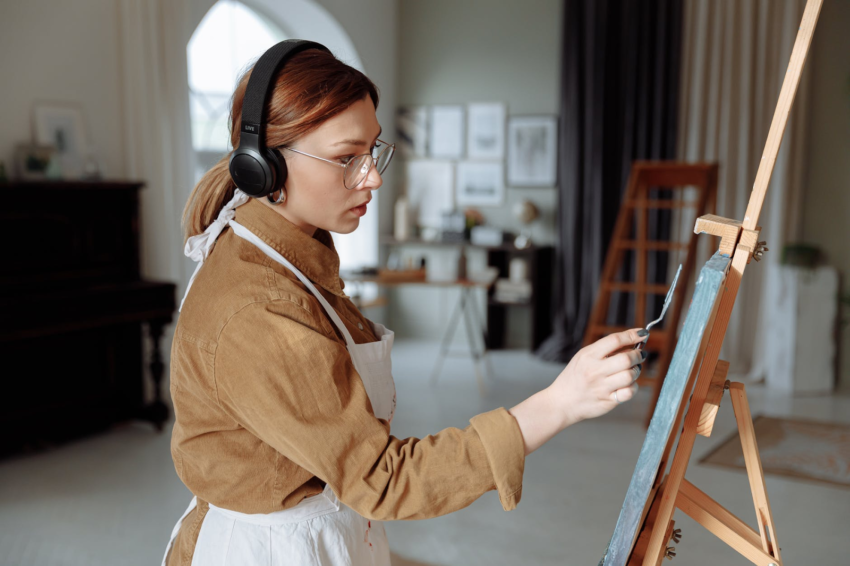Music and art are both expressions of creativity that share the freedom of expression. However, these two ways of expressing emotions and experiences are not the same because they involve different channels of perception. Art is related to the eyes, and music is perceived by the ears.
Despite this distinction, music and visual art are frequently linked. Art and music lessons were taught as part of classical education in Ancient Greece, and the tradition is still carried on in some educational systems today. However, these two spheres gained special attention at the beginning of the 1900s. Wassily Kandinsky, a Russian artist who is considered one of the first abstractionists, devoted many of his works to this connection. His series of pictures was named after musical genres and specific terms.
Today, the influence of music and art on each other is still being explored, and more and more artists are talking about how music affects their creative process. Musicians frequently visit art galleries for inspiration, and artists frequently use audio sets while painting. Modern technology makes it easier to enjoy any style of visual art or music. You can visit many art galleries on an online tour, and the music can be played through a portable device, such as the best soundbar under 300.
The Сonvergence of Art and Music in Linguistics and Psychology
Art is a way of manifesting one’s mind and relaying this to society. Language and psychology provide the means to study the mind and society. That’s why, by learning about the possible connections between visual art and music within these aspects, we can discover how they work together or influence each other.
Many fine art terms are used to describe musical concepts. For example, the term “chromatic” is used to describe a musical gamma type and also a category of colors. “Coloratura” refers to a piece of music with multiple decoration elements. “Nocturne” stands for a form of musical composition that expresses a dark, nocturnal mood. “Rondeau” is an allusion to a visual form, the circle, and is used to denote a specific compositional form with repeating parts.
In psychology, the connection between the visual and auditory channels is often studied in mind-influencing methods such as NLP. It’s postulated that people tend to preserve and describe their impressions through their predominant channel of perception. For example, a man with the predominant audial channel will most likely categorize some visual object as “boomy”, “dynamic”, and “ringing”. Meanwhile, another man with the predominant visual channel would use terms like “dark”, “colorful”, and “angular” to express his perception of a musical piece. It was also noted by many researchers that these patterns of inter-perception are similar for most people.
Colors and Connection to Music
Many painters claim that the music they listen to influences their color choices. When listening to songs dominated by bass and beats, they tend to choose darker, more saturated colors. When the music is relaxing and slow, the color gamut of the painting is more likely to be pastel, without particularly bright spots and contrast motives.
The mood of the music is often reflected in the choice of color for a painting. This is closely related to chromesthesia. For example, while listening to a drama, an artist is likely to prefer achromatic colors and emphasize contrasts. If dynamic folk music is chosen as the accompaniment, chromatic colors will prevail. Slow music with moderate dynamics is likely to be reflected in a variety of less contrasting pastel hues.
How Music Affects Painting Techniques
Experts say the music forms a mood, and thus, can be used as a tool in painting. Specific aspects of music can also influence the choice of a painting technique. Slow, peaceful music is frequently associated with rounded forms and small marks in art. In contrast, a dynamic composition will encourage the artist to use larger strokes and more angular forms.
If you want to create a detailed picture with many nuances, it is better to choose a slow and unobtrusive audio composition, with a minimum of bass. However, it’s better to avoid vocals, as the vocal part tends to catch the attention and might divert you from your subject. For pictures that require dynamics, choose appropriate music. This will help you feel the rhythm and reflect it in your artwork.
How Visual Art Affects Music
Most research has focused on the influence of music on painting and other visual arts. However, this connection is reciprocal, and musicians can also use the associations between auditory and visual perception. To be inspired by a genre such as the blues, it is advisable to look at impressionist paintings, with lots of color nuances. If you need to compose a dynamic music piece, look for the paintings with the big marks and bright contrasts, depicting some dynamic events (for example, the launching of a rocket). For a piece of classical music, study the paintings with the standard color gamut and moderate contrast.
The universal mechanisms of human perception allow us to control the creative flow and regulate it in the way intended by the artist or musician. However, the individual component is important as well. When selecting a painting or a piece of music to accompany and inspire your work, consider your personal preferences. Picking the painting or a composition that you like will undoubtedly boost your creativity and expand the range of instruments used, for the accurate depiction of your emotions in art and music.
